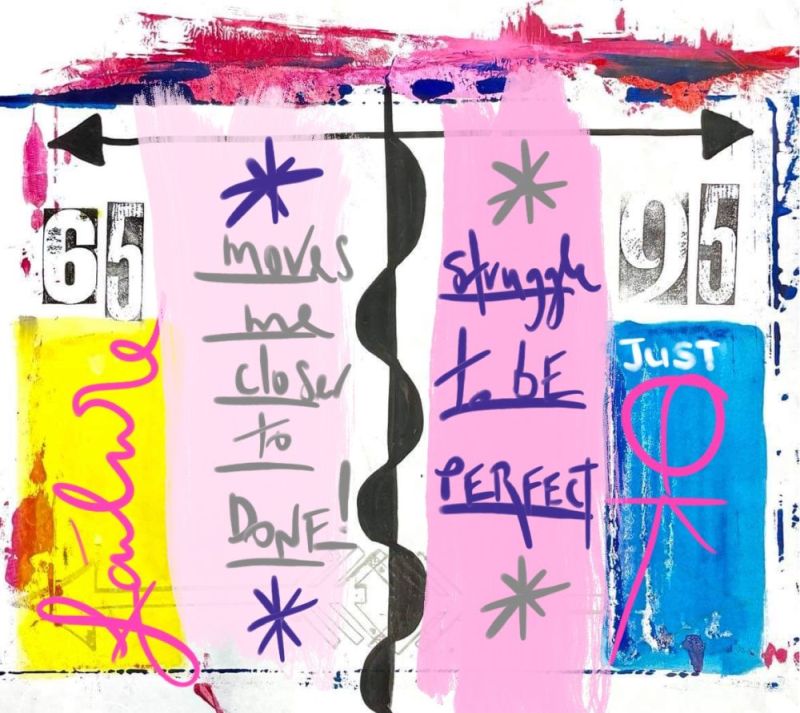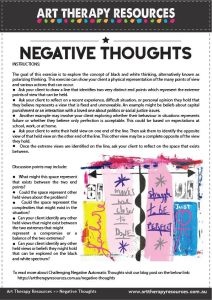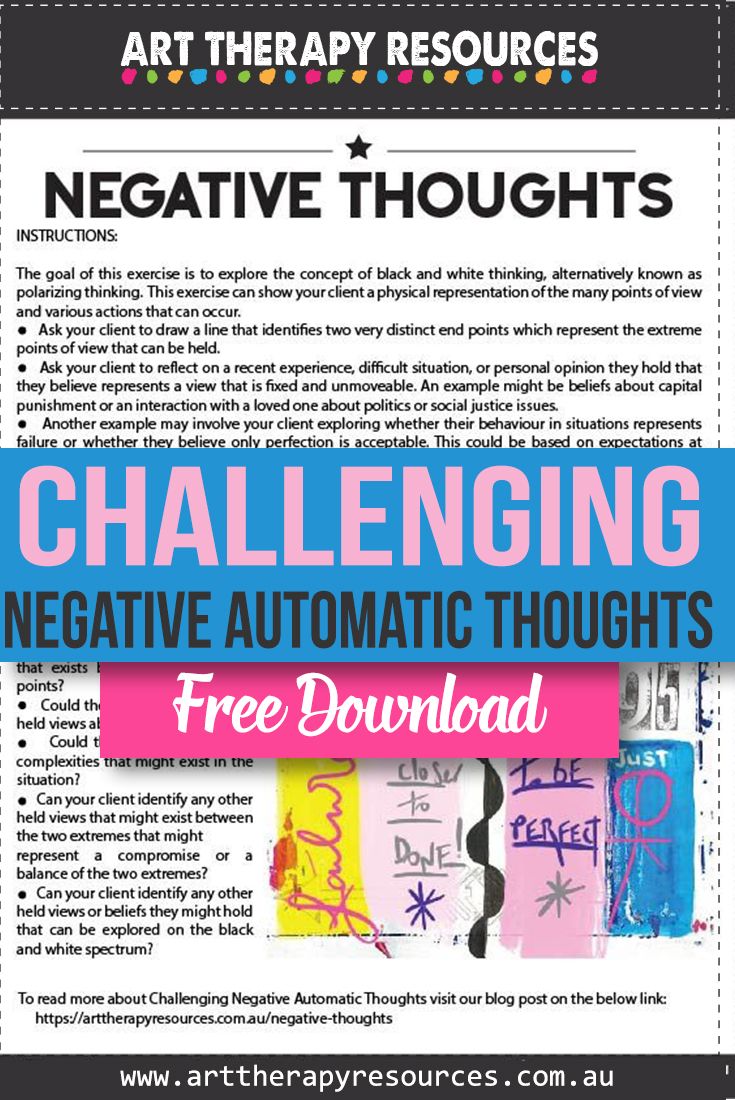THIS POST INCLUDES:
1. What are automatic thoughts
2. Challenging negative automatic thoughts
3. How Art Therapy can help negative thoughts
4. Free Download Art Therapy Exercise
WHAT ARE AUTOMATIC THOUGHTS
Most of our automatic thoughts are rudimentary and help guide us through our day so we are not overloaded with intense decision making. However, other automatic thoughts can be detrimental and have a negative impact on our life. This is especially true when the thoughts are pervasive and enduring over an extended period.
While most automatic thoughts occur without specific effort from us, we can identify a clear pathway of how they develop in our thinking.
Initially, we are presented with a trigger. It might be visiting a place or seeing a person for example
- this may trigger a belief we hold based on past experiences, eg. This place is stressful
- this leads to engaging in automatic thoughts eg. this place is going to cause me stress
- this leads to emotions, eg. Elevated feelings of stress
- this leads to behavioural actions, eg. Anger, avoidance, anxiety etc
All of this can happen in a matter of seconds which leaves us little time to identify each step to try and interrupt the automatic process.
The most common automatic thoughts we have can be summarised as below:
- Catastrophizing
- Black and white thinking
- Generalisation
- Jumping to conclusions
We may not be able to stop automatic thoughts from initially occurring but the goal is to learn methods to identify the damaging thought and then develop strategies to disrupt the thoughts at any point along the pathway.
CHALLENGING NEGATIVE AUTOMATIC THOUGHTS
In therapy, we can work with clients on specific experiences a client may have that they know creates distress for them. We can work with the client to create a framework around the experience so that each step of the pathway can be safely explored.
As these experiences are negative they can create emotional distress. This is especially true when recalling the experience, however, this is also true when developing a strategy to cope with the events as they often reinforce negative beliefs we may hold about ourselves and our ability to problem solve and cope with emotional distress.
In these instances, we can be impacted by both the event itself as well as the recovery process.
As we saw above the general pathway of negative automatic thoughts is:
Trigger > thoughts > emotions > behaviours
As a process of changing the pathway for the future, it’s important for clients to understand the points of the pathway that they can make changes.
Clients may not be able to change the trigger or exposure to the trigger. An example of this is for a child who lives in an abusive household. They may not be able to leave home. Another example is someone who may be experiencing workplace bullying and is unable to leave their job.
The second step is the activation of thoughts. If the trigger cannot be avoided, it is difficult to stop thoughts from occurring. A well-known example of automatic thinking is when you’re told to not think about an elephant…and then you immediately think of an elephant. Our emotional, cognitive, and physical reactions can be difficult to control in many situations.
So far we can see that the trigger and the thoughts are difficult to eliminate. However, it is at the next step that we can begin to initiate some change.
HOW ART THERAPY CAN HELP NEGATIVE THOUGHTS
Creating art can give clarity to defining and understanding problems and it can also help provide insights for problem-solving. Using art materials and transposing abstract thoughts to a physical art surface can help clients understand there is a pattern to their thoughts and that these thoughts can be transformed just as art can be transformed.
The process of art making also provides the client with a space to explore personally held beliefs about their approach to trying new things when creating art. This can provide insight for the client to view their reactions to making changes to held beliefs about other parts of their lives.
When working with a client, the creative space can be a sacred space of acceptance, non-judgment, and compassion. These important attributes can be incorporated into the client’s toolkit of coping with other problems outside of the art making environment.
While it is helpful to dissect the intellectual components of negative automatic thinking, art therapy can help clients connect with the emotional aspect also.
Art therapy provides a space for the client to let the flow of thoughts transpire through the art medium instead of relying on verbal filters that may attempt to self-sensor or rationalise outside of the emotional connection. Art provided a conduit for the problem to exist and disclose when the client is ready.
ART THERAPY EXERCISE
INSTRUCTIONS:
The goal of this exercise is to explore the concept of black and white thinking, alternatively known as polarizing thinking. This exercise can show your client a physical representation of the many points of view and various actions that can occur.
- Ask your client to draw a line that identifies two very distinct end points which represent the extreme points of view that can be held.
- Ask your client to reflect on a recent experience, difficult situation, or personal opinion they hold that they believe represents a view that is fixed and unmoveable. An example might be beliefs about capital punishment or an interaction with a loved one about politics or social justice issues.
Another example may involve your client exploring whether their behaviour in situations represents failure or whether they believe only perfection is acceptable. This could be based on expectations at school, work, or at home. - Ask your client to write their held view on one end of the line. Then ask them to identify the opposite view of that held view on the other end of the line. This other view may be a complete opposite of the view they hold.
- Once the extreme views are identified on the line, ask your client to reflect on the space that exists between.
Discussion points may include:
- What might this space represent that exists between the two end points?
- Could the space represent other held views about the problem?
- Could the space represent the complexities that might exist in the situation?
- Can your client identify any other held views that might exist between the two extremes that might represent a compromise or a balance of the two extremes?
- Can your client identify any other held views or beliefs they might hold that can be explored on the black and white spectrum?
An example of the exercise is shown below:

FREE DOWNLOAD: Art Therapy Exercise
SIGN UP below to download the FREE Art Therapy Exercise focusing on Challenging Automatic Negative Thoughts.

BUILD YOUR ART THERAPY REFERENCE MATERIALS:
Pin this image to your Pinterest board.

SHARE KNOWLEDGE & PASS IT ON:
If you’ve enjoyed this post, please share it on Facebook, Twitter, Pinterest. Thank you!
